|
Copyright © 2003 Kevin O'Rourke
The site is a work in progress, the 'Album' page in each section contains some photos but only some sections have much text.
Contact me
|
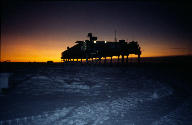
|
16-2:The main accommodation platform at Halley. Around midwinter this is as light as it gets.
|
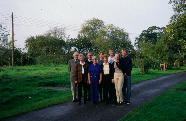
|
1-36:For my last couple of days in the UK we had a family holiday in Lincolnshire, in the picture are (left to right, front to back) my grandmothers, mum and sister Eleanor, grandfathers, sister Clare, myself and dad.
|
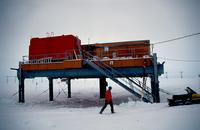
|
3-26:This is the Piggott/Space Science building, where I usually worked. To the right of the picture is one of the ancient skidoos used as summer transport. Behind the building you can see the SHARE antenna array. This kind of weather is unfortunately not very uncommon at Halley, the lack of contrast makes it difficult to see if you're just about to fall into a hole or trip over a lump of snow.
|
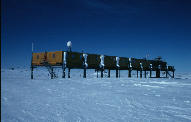
|
51-8:The ACB/Laws building again, this time in daylight. Bedrooms are at the left hand end of the building, the bar, dining room and living room in the middle and the workshops and generator shed are at the right hand end. The open platform area is used as temporary storage for waste and supplies.
|
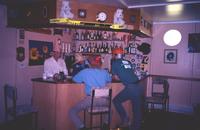
|
9-34:The Halley Bar (also known as the Hard Ice Cafe). Towards the end of the night a few people refuse to give the nightwatchman any peace.
|
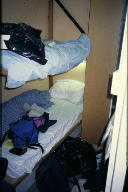
|
19-37:My bedroom. It really was as small as it looks, but not always this untidy. I was in the middle of packing for a field trip when I took this picture. During the summer two people share one of these rooms. The lack of soundproofing meant that people in adjacent rooms could hear each other breathing at night.
|
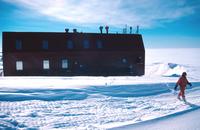
|
51-24:The Summer Accommodation or Drewry building. The two metres of snow accumulation each year mean that it has to be winched out of a hole and onto a mound every year to avoid burying. This is also the emergency accommodation should the ACB burn down during winter.
|
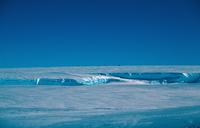
|
33-5:At the beginning of the winter the base members go on seven-day trips to what is known as the hinge zone, where the floating ice of the Brunt Ice Shelf meets the ice sliding down from the plateau. You can just see our camp in this picture.
|
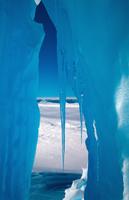
|
33-24:Aladdin's Cave is a favourite feature of the Hinge Zone, a natural tunnel through one of the many frozen-in icebergs. During summer it's warm enough for the ice to start melting, resulting in beautiful icicles.
|
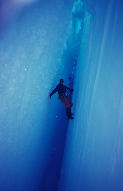
|
9-8:Part of the fun of the field trips to the Hinge Zone is in practicing important techniques such as abseiling and jumaring, to allow us to rescue ourselves should we fall into a crevasse. Only blue light filters through the ice and snow and the bottom of the crevasse is often hidden in the deep blue gloom.
|
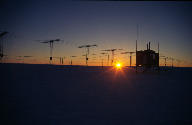
|
8-15:Much of the electronics for the SHARE radar is contained in a shipping container fitted out as an office and workshop, known as the SHARE caboose. This was my own little space, where I could be alone if I wanted to. You can see some of the sixteen radar antennas here and if you look carefully there is a small crowd of Adelie penguins to the right of the caboose.
|
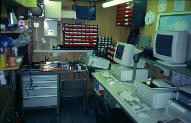
|
14-26:The inside of the caboose was quite comfortable, especially after I refitted it at the beginning of my first winter. The computers on the right control the radar and process the data from it. On the workbench at the far end is one of the 600W transmitter trays brought in for maintenance. They are normally mounted in steel boxes attached to the antennas.
|
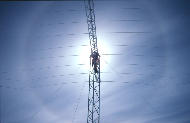
|
kh17-6:David Glynn, the 2000/2001 SHARE engineer carrying out one of the regular maintenance tasks on the radar. The stays which support and stabilise each antenna tower get pulled tight by the accumulating snow and have to be slackened off to prevent damage. The halo surrounding Dave is caused by tiny ice crystals in the air.
|
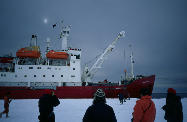
|
5-23:The beginning of my first winter, the last few people board the RRS Bransfield as she prepares to leave, in February 1998. After this the sixteen winterers will be the only human beings for hundreds of miles until the first aircraft arrive in October.
|
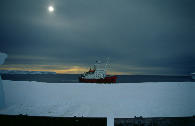
|
7-36:The Bransfield leaving the Brunt Ice Shelf, we had to drive off before the ship left in case the sea ice broke away.
|
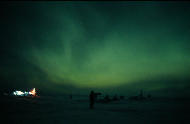
|
11-23:Halley is located in an area of high auroral activity, which is good for science and also provides spectacular sights for the winterers. The startling beauty of auroras can't be captured on film as the long exposures (about 1 minute) blur the fine detail. The brightly lit area on the left is the melt tank (see below).
|
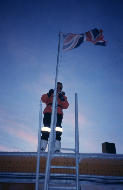
|
14-37:Dave Routledge (our captive mountaineer) lowers the flag at sundown. This is a job traditionally reserved for the oldest base member, the youngest raises the new flag at sunup. After sundown the sun won't appear above the horizon for 105 days.
|
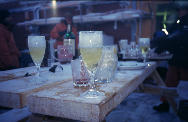
|
13-1:Having a barbecue outdoors in Antarctica creates some special problems, it's very important to drink your champagne before it freezes solid.
|
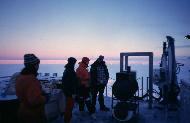
|
14-31:Sundown is usually celebrated by a barbecue on the open platform. On the left you can see the empty 45 gallon fuel drums used to store waste for removal to the Falklands.
|
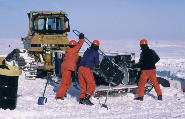
|
fh1-26:Two years worth of fuel is stored at Halley. Although the drums are piled up on the surface at first they are soon buried by the accumulating snow and have to be pulled out using a crane. Here some of the winterers are lifting the drums to an upright position.
|
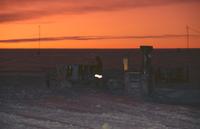
|
fh1-2:The ACB and SSB each have large rubber fuel tanks ('flubbers') in the sub-surface service tunnels. Every few months everyone on base is occupied for a day in the cold job of pumping fuel down from drums into the flubbers.
|
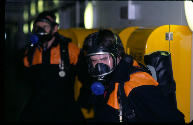
|
fh1-21:Fire is a real danger living in a wooden structure in a place as dry as Antarctica. Without a Fire Brigade we all had to be trained in the use of breathing apparatus in case we had to rescue base members from a smoke filled room. Gary Wilson and Dave Whitren are shown during their monthly refresher training, checking the correct function of the equipment.
|
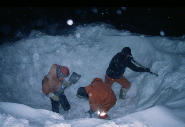
|
fh3-26:All of the water from the base is supplied by melting snow in a large sub-surface melt tank. This has to be filled every day and in windy conditions this is not a fun job.
|
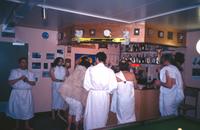
|
13-21:You have to make your own entertainment on an Antarctic research station, in this case a combined toga party and photographic competition.
|
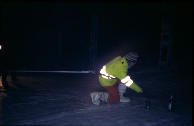
|
15-18:An even more bizarre form of entertainment was devised by John Strachan for Midwinter 1998. He prepared a specially polished ice run under the ACB, with various alcoholic prizes at the end. The challenge was to run up and grab the prizes while tied to one of the legs by elastic ropes. In this picture Steve Leighton is reaching out for a can of beer shortly before being cruelly snatched away.
|
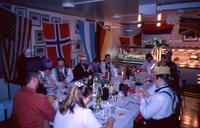
|
15-25:Midwinter has been celebrated by Antarctic expeditions since the days of Shackleton and Scott. The dining room is decorated, everyone dresses up and the chef spends all day preparing an enormous meal.
|

|
9-20:John Strachan tries to beat the record with the drinking helmet. Both cups are initially filled with beer, which you then have to suck through the scuba mouthpiece as fast as possible. You can end up looking very silly.
|
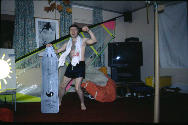
|
fh3-37:Another successful social event was the beach party, Jon Paddle really got into the spirit of things.
|
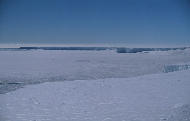
|
25-33:Despite these activities it's always good to get off base, especially if it's down to the coast to see the penguins. Windy Creek is the site of a large colony of Emperor penguins, which you can see in the middle of this picture (but only just).
|
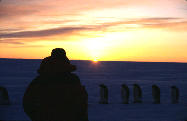
|
fh5-2:At the beginning of the winter the penguins walk towards their colony site. They can only survive the cold by huddling together.
|
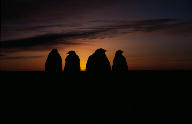
|
43-18:This pictures was taken in August 1999, on the day that we first saw the sun again. It was amazing to be down on the sea ice with the penguins and see the sun just peeking over the horizon.
|
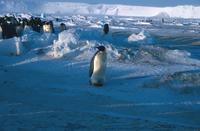
|
48-1:Despite the cold penguins are very curious and will often waddle over to inspect visiting winterers. It can sometimes be surprising to look up from your camera viewfinder and find yourself surrounded by a small crowd of them.
|
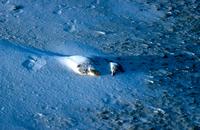
|
48-11:Not all of the penguins survive the winter and survival is especially difficult for the new-born chicks. If they fall off their parent's feet they usually end up like this one.
|
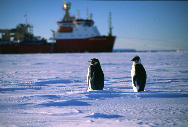
|
fh6-3:By my last summer the Bransfield had been replaced by the RRS Ernest Shackleton which you can see in the background of this picture. The penguin on the right here is moulting resulting in its unusual 'mohican'.
|
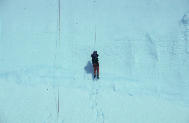
|
kh25-14:Most visits to the penguin colony ended by climbing back up the ice cliffs as there weren't always convenient natural ramps.
|
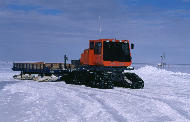
|
25-6:During the hectic week of relief, unloading cargo from the ship, there are a variety of jobs to be done around base. I spent two reliefs in the cab of Sno-Cat K19, ferrying cargo between the coast and the base. This was made much more fun by the stereo which Dugly set up on the back seats.
|
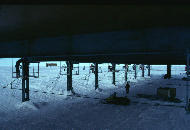
|
kh25-22:The accumulating snow also means that the platforms must be raised every year, in this case the ACB. The jacking is done by electric motors with a person on each leg to switch the motor on and off.
|
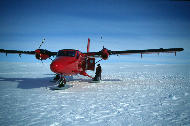
|
6-20:The BAS fleet of Twin Otters are essential for deploying field parties of scientists during the summer. All of the winterers get the opportunity to go along on one or two flights.
|
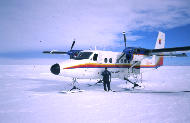
|
fh6-29:Twin Otters are the most popular type of aircraft in Antarctica. In late 1999 we had a couple of visits by First Air Twin Otters working for Adventure Network International, the only tour company working on the Antarctic continent.
|
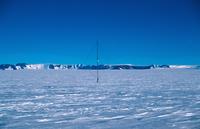
|
31-4:In my middle summer I spent five days out at a remote Automated Geophysical Observatory as part of a maintenance team. The best part of this was living close to the Shackleton mountains, the first rock I had seen in over a year. The antenna in the foreground picks up very low frequency radio signals, which are used to study the upper atmosphere.
|
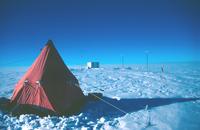
|
31-6:Here you can see one of the tents and the automated observatory, A81. The equipment is powered by a combination of solar and wind power and is intended to operate year round. This site had unexpectedly high snow accumulation so we had to raise the hut several meters so that it stood above the surface.
|
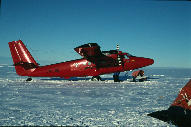
|
kh1-2:One of the reasons Twin Otters are so popular in the Antarctic is that they can be repaired easily in the field. Here some maintenance on the front ski is being carried out by weighing down the tail of the aircraft.
|
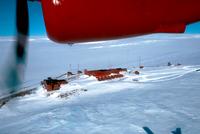
|
50-36:This was the closest I got to visiting our Argentinian neighbours at General Belgrano III base to the west of Halley. We were flying back from a day spent building a fuel depot and did a few circuits over the base to get photos.
|
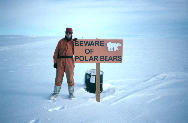
|
kh17-9:This was taken as we drove down to the ship, leaving Halley for the last time. The sign was a joke, most people going to Antarctica get asked about whether there are any polar bears at least once.
|
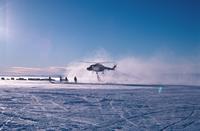
|
kh1-10:I left Halley early with a few other people to help with a major depot-laying operation near Berkner Island. The HMS Endurance joined the Shackleton and provided helicopters to ferry the fuel from the ship to the shore. From there it was loaded into Twin Otters and flown to the final depot site.
|
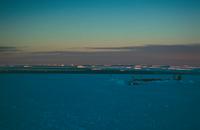
|
kh1-14:This picture shows the scene in the evening, with the icebergs out at sea reflecting the last of the sunlight. To the right is the tent used by the Royal Marines sent to help us load the aircraft. It looks like nobody told them that putting a tent up in a pit is a bad idea when there's drifting snow...
|
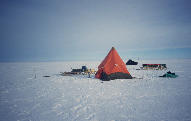
|
21-6:Going back to before I left Halley this is a picture from one of my end of winter, ten day field trips. In both years I went on long-distance skidoo trips with Paul Cousens and Matt Pickles, as well as Dave Routledge (in the first year) and Ian Marriott (in the second). This is Christmas Box Hill (aka the Lyddan Ice Rise), our destination in 1998. We spent three days driving to get to the highest point for miles around, camping every night.
|
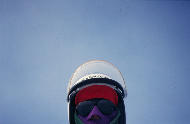
|
21-12:It's difficult to tell but this is actually me driving my skidoo on the way to Christmas Box Hill. Even in October it's still cold enough to need a facemask to prevent frostnip and every stop meant the agony of defrosting partially frozen hands.
|
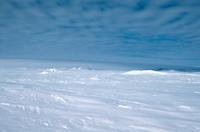
|
49-22:This was our destination, Christmas Box Hill. Not the most dramatic scenery, I'd have to say, but getting there is half the fun. The rest of the fun was relaxing for three days on top of it and driving back.
|
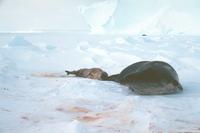
|
49-33:On the way back we went via the coast and spotted this Weddell seal and her new-born pup. The pup was very cute, rolling around on the ice, but his mother (understandably) didn't want us to get too close.
|
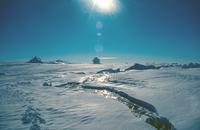
|
47-26:For our second long field trip we headed for an area of low ice shelf to the east of Halley. Although we were over fifty kilometres from the coast the shelf dropped right down to sea level. In some parts the ice was moving so quickly that the sea didn't have the chance to refreeze, leaving these areas of open water.
|
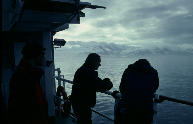
|
kh1-38:Once we had left Halley and finished our depot-laying work the Shackleton picked up the remaining departing winterers and summer staff from Halley and headed north. Our first landfall was Signy Island, one of the South Orkneys. It was very odd to see solid land appearing out of the early morning fog, most of us hadn't seen land for two years.
|
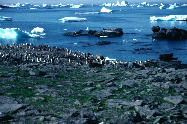
|
kh21-24:It may be dry land but there are still penguins. This was a colony of Gentoo penguins, which we walked across from Signy base to see.
|
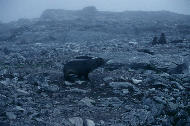
|
kh23-22:Fur seals aren't my favourite animals. They may look a bit cute but they bite, they smell and they make a really irritating whining barking noise. On the other hand the have made a remarkable recovery after being hunted almost to extinction for their skins.
|
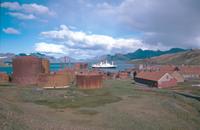
|
kh24-13:After Signy we stopped off at South Georgia, famous for its whaling stations and as the destination of Shackleton's epic small boat journey. This is the harbour at Grytviken, the last of the whaling stations to close down. A cruise ship arrived at around the same time as us so we were joined by a crowd of (mostly) elderly Americans in identical red jackets.
|
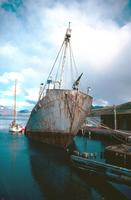
|
kh24-27:The whale catcher Petrel was abandoned in the harbour at Grytviken. Moored alongside is the Curlew, home of Tim and Pauline Carr, the curators of the South Georgia museum.
|
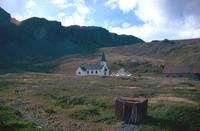
|
kh24-19:While most of the buildings at Grytviken are being allowed to fall into decay the Norwegian Whalers' Church has been carefully restored and maintained. Above and to the right of it the remains of the ski jump can be seen on the hillside. The ruins of the cinema lie in front of it.
|
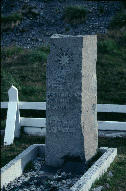
|
kh22-6:When Ernest Shackleton died while attempting to return to Antarctica it was decided that the most fitting place to bury him would be South Georgia. Visiting ships often leave small plaques on the grave as a mark of respect.
|
journeys/Zalbum.html last updated:
Fri Feb 29 14:17:24 2008
![[WebMake logo]](../media/BuiltWithWebMake.png)
|
![[Journeys logo]](../media/logo.gif)
![[Journeys logo]](../media/logo.gif)